
In 1990, the International Journal of Radiological Biology published a paper by M. Mine and his team of Japanese researchers entitled “Apparently beneficial effect of low to intermediate doses of A-Bomb radiation on human life-span.”† Mine’s team gleaned data from the “Health Handbook” that A-Bomb survivors were required to keep, recording every health change. They scrutinized data on over 80,000 subjects whose locations could be pinpointed at the time of the blasts, and determined the correlation between the relative risk of death and the dose of radiation received.
The study indicated quite the opposite of what was expected. The healthiest survivors were those who received approximately 10,000 mrem (millirems) of radiation in a very short time — a second or less. (See the main article, “Fukushima: Just How Dangerous Is Radiation?” for a discussion of radiation dose measurements.) This is about three million times the highest dose rate of radiation in the exclusion zone adjacent to the Fukushima complex — which has been in the news because of the radioactive releases there resulting from the 9.0 earthquake and resulting tsunami. The amount of radiation received by the healthiest survivors is approximately equal to 105 years of radiation that one might now be exposed to in Tokyo at the current rate of 0.109 microsieverts per hour, which is causing foreigners to return home where radiation levels are in many cases, ironically, much higher than Tokyo.
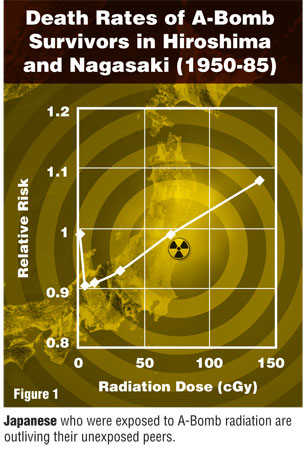 Mine’s data, plotted in Figure 1 for males shows that up to 75,000 mrem — a massive amount compared even to what nuclear workers in Japan have received — resulted in lifespans longer than their unexposed peers. The graph shows each group’s relative risk — the exposed people who actually died compared to deaths in a similar unexposed cohort — as a function of the radiation dose. (The dose shown was from the blast only and didn’t include subsequent fallout or the increase in background radiation, factors that would indicate an even greater benefit for the exposed compared to the unexposed.)
Mine’s data, plotted in Figure 1 for males shows that up to 75,000 mrem — a massive amount compared even to what nuclear workers in Japan have received — resulted in lifespans longer than their unexposed peers. The graph shows each group’s relative risk — the exposed people who actually died compared to deaths in a similar unexposed cohort — as a function of the radiation dose. (The dose shown was from the blast only and didn’t include subsequent fallout or the increase in background radiation, factors that would indicate an even greater benefit for the exposed compared to the unexposed.)
The massive increase in cancer mortality predicted by Linear No Threshold theory (LNT) — the theory that the U.S. government relies upon to determine the danger posed by exposure to radiation — 20 to 30 years after exposure was clearly not valid. One would expect that government regulators and the radiation protection industry would be overjoyed at the results of this epidemiological blockbuster. That was not the case. The study did not change anything in the official treatment of radiation risks, even in Japan where the longevity of blast victims is common knowledge.
Hormesis
In 1980, unnoticed by most of the scientific community, T.D. Luckey, then-chairman of the biochemistry department at the University of Missouri Medical School, published a book entitled Hormesis With Ionizing Radiation. It documented some thousand experiments where fungi and other lower life forms were seen to prosper with doses of radiation exceeding their normal background exposures. (Background radiation is ubiquitous — in the food we eat, the soil, buildings, and even our own blood.) A second book, in 1991, Radiation Hormesis, examined hundreds of studies on man and animals showing that low levels of radiation were beneficial to health, longevity, and reproduction.
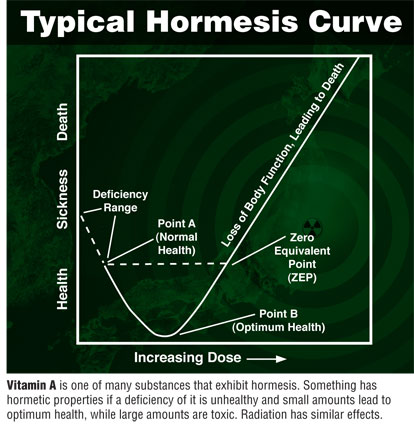 How does a known dangerous agent like ionizing radiation bring about healthful benefits? In the simplest terms: A low level of any stressful force tends to activate the body’s defenses. This is true for most, if not all, medicines. An aspirin tablet does not directly reduce headache or arthritis pain; it stimulates the body to create suppressants to prostaglandins that transmit pain to the brain. Similarly, inoculations do not directly prevent disease, but stimulate the immune systems to gird itself for battle in order to overwhelm a disease. Physiologically, radiation increases the production of lymphocytes, enhances the number of immune system helper T cells while inhibiting the suppressor T cells, and increases the activity of the p53 protein. (Please see your friendly biochemistry professor for answers to your questions on the last sentence.)
How does a known dangerous agent like ionizing radiation bring about healthful benefits? In the simplest terms: A low level of any stressful force tends to activate the body’s defenses. This is true for most, if not all, medicines. An aspirin tablet does not directly reduce headache or arthritis pain; it stimulates the body to create suppressants to prostaglandins that transmit pain to the brain. Similarly, inoculations do not directly prevent disease, but stimulate the immune systems to gird itself for battle in order to overwhelm a disease. Physiologically, radiation increases the production of lymphocytes, enhances the number of immune system helper T cells while inhibiting the suppressor T cells, and increases the activity of the p53 protein. (Please see your friendly biochemistry professor for answers to your questions on the last sentence.)
Luckey’s and Mine’s research spawned a worldwide interest in radiation hormesis, a term that Luckey popularized although it had been used earlier by non-radiation researchers in 1946. The International Dose-Response Society was formed at the University of Massachusetts-Amherst as a vehicle to provide a forum for research into both radiation and many chemical agents that exhibit the hormetic effect — the phenomenon that many agents are toxic in large amounts but are beneficial or therapeutic in smaller doses. Our bodies require vitamins and trace elements such as arsenic and selenium that are poisonous in large amounts. Salt exhibits similar effects — it’s required for life in small amounts but deadly in large ones. Even too much water can cause coma or death from a condition known as hyponatremia.
We certainly already knew about the health effects of another form of radiation: sunlight. Moderate amounts of sunlight cause the skin to produce Vitamin D, without which our health suffers and we develop a prison pallor. Above our optimum exposure, we get progressively painful burns and, as we know from victims staked to the desert floor in cowboy movies, death. Since sunlight, in particular the ultraviolet content, is the closest in the electromagnetic spectrum to X-rays, which in turn overlap with gamma rays from nuclear activity, it would be surprising if nature did not treat ionizing radiation similarly.
Proving Out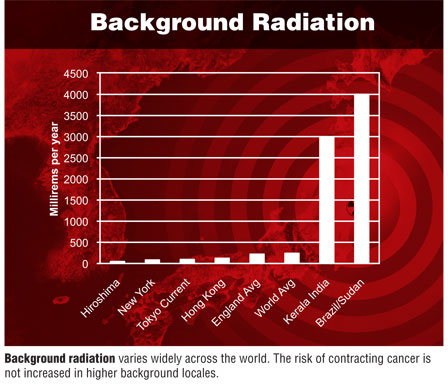
Subsequent review of research papers — this time looking at the beneficial effects on the test subjects (mostly mice) — showed that the growth rate for mice was highest when they were exposed to 100,000 mrem of X-rays per day. Mice exposed to low doses of gamma or X-rays (and some not so low) had less leukemia mortality, and lower rates of both pituitary and lung cancer. Eighty percent of mice that were exposed to 50,000 mrem were alive 30 days after a second exposure of 740,000 mrem, while only eight percent of those who did not receive the “inoculatory” dose survived the month.
But it was taking a closer look at data on low-level radiation exposure on humans that was really eye-opening. Consistently, nuclear plant and fuel workers have less cancer and better health than the general population, and we’re not talking about just a token reduction. At the Oak Ridge National Laboratory in Oakridge, Tennessee, where nuclear research has been conducted for the U.S. government since the WWII-era Manhattan Project, data from 200,000 man-years of work from 1950 to 1963 showed a reduction in mortality from 992 deaths predicted by the U.S. Bureau of Vital Statistics, to 692 actual deaths. In Los Alamos, workers exposed to 100 mrem of radiation had only 58 percent of the cancer mortality expected in the general population. And at the Rocky Flats weapons plant in Colorado, 7,112 plutonium workers employed from 1952 to 1979 had only 64 percent the expected deaths of the general population.
Shipyard Workers
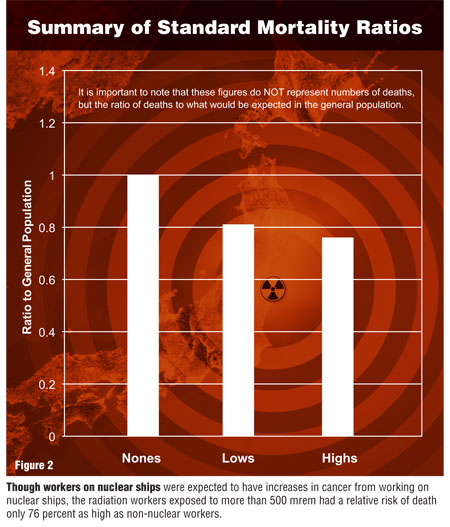 In 1980, a Department of Energy contract was granted to the Department of Epidemiology at Johns Hopkins University to examine the “Health Effect of Low Level Radiation in Shipyard Workers.” The study was expected to show an increase in cancer mortality in those employees who worked on nuclear vessels when compared to fellow workers who were assigned to non-nuclear ships. No chance here of a skewed study as a result of “healthy worker effects” — where healthier workers are preferred over less healthy ones — as they were hired at random from the same employment line.
In 1980, a Department of Energy contract was granted to the Department of Epidemiology at Johns Hopkins University to examine the “Health Effect of Low Level Radiation in Shipyard Workers.” The study was expected to show an increase in cancer mortality in those employees who worked on nuclear vessels when compared to fellow workers who were assigned to non-nuclear ships. No chance here of a skewed study as a result of “healthy worker effects” — where healthier workers are preferred over less healthy ones — as they were hired at random from the same employment line.
The initial pool of examinees consisted of 700,000 workers, including 104,000 nuclear workers at two private and six government shipyards. To insure comparable cohorts, the list was pared down to 72,356 subjects. Workers were divided into three categories:
•The non-nuclear workers (“Nones” in Figure 2), comprised of 33,352 employees, were used as the controls.
•Those who had cumulative exposures of less than 500 mrem, whom we will refer to as the “Lows,” totaled 10,462 workers.
•The 28,542 workers who exceeded the 500 mrem benchmark are designated “Highs.”
Let’s get some perspective here. National opinion polls that are used to influence public policy are often based on 1,000 “likely voters.” These polls get rapt attention from the media. This study is based on 72,000 individuals chosen because they had common attributes with others in the study. Selection was scientific, not random as in most opinion polls.
This investigation, known by radiation protection professionals as “the largest study that never was,” is so named because of the many years it was not published after completion. Why? The government had commissioned an investigation to show how low-level radiation caused cancer, but the data showed just the opposite. (U.S. government agencies have a radiation protection policy based entirely on LNT theory.) What is an investigator going to do? He waffles and postpones publication, hoping no one will remember the study was done. But some people did remember.
The statistic that sticks in the minds of almost everyone who has studied the report is shown on the bar graphs of Figure 2. For deaths from all causes, the Nones registered exactly what they should have: the same mortality as the general population. (This factor gives credence to the methodology of the investigation.) The Lows had 81 percent of their expected mortality. Incredibly the Highs had only 76 percent of their expected death rates. Remember, all three cohorts mingled in the same employment lines, but some were lucky enough to be called to work on nuclear ships.
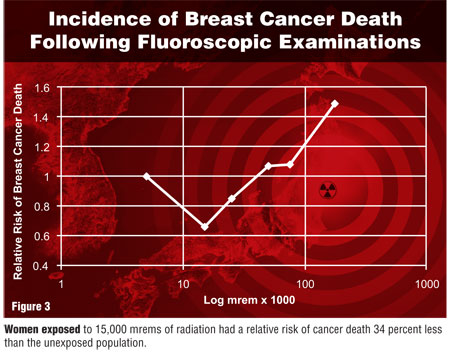 Radiation and Breast Cancer
Radiation and Breast Cancer
Published in the New England Journal of Medicine in 1989, an investigation by A.B. Miller and associates charted the doses received by 37,710 Canadian women who were irradiated in the course of repeated fluoroscopic breast examinations between 1930 and 1952. In the case of the cohort from Nova Scotia, examinations were made facing the X-ray source, resulting in a dose about 25 times that of those who were facing away. With accumulated doses in the hundreds of thousand millirems, their cancer rate followed predictions of the LNT.
But those who received cumulative doses of 10,000 to 30,000 mrem saw their relative risk of breast cancer death drop to as low as 66 percent of that of an unexposed woman of similar background. Figure 3 presents the data that caused Myron Polycove, M.D.‡ to remark:
The decreased risk rate of breast cancer produced by low dose, low level radiation were rejected a priori by the choice of mathematical models that extrapolate the dose-risk relation from high dose exposures to low dose exposures.
In case you missed it, he is speaking here to the fallacy of LNT. Dr. Polycove continues:
Nine hundred excess deaths from cancer are predicted theoretically from the exposure of one million women to 0.15 Gy [15,000 mrem]. However, the quantified low dose data predicts with better than 99% confidence limits that instead of causing 900 deaths, a dose of 0.15 Gy would prevent 10,000 deaths in those million women.
Nobody — no government agency, no academic society, no anti-cancer organization — argues with these figures. The figures are merely ignored, as they don’t pass the politically-correct test that all radiation is dangerous and that it takes only one gamma ray to cause cancer.
One must wonder with a breaking heart as to how many of our friends and relatives who succumbed to breast cancer could have been saved by the painless, nearly free, only-takes-a-minute application of low-dose radiation as a simple preventative measure.
Hold Your Breath, ?Radon Is All Around You
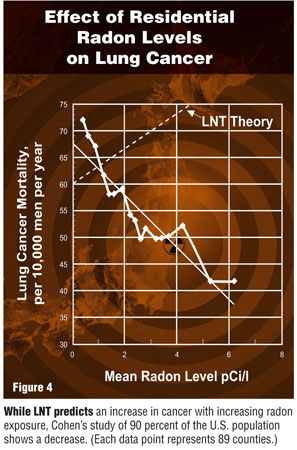 We were introduced to Professor Bernie Cohen in the cover story, where he pointed out an inordinate number of news stories on radiation that caused no deaths, and far fewer articles on automobile accidents causing hundreds of thousands fatalities. Besides a background in nuclear physics, he is renowned as a master of “risk analysis.” He directed a project of Pittsburgh University that was expected to document the dangers of radon in increasing the risks of lung cancer. Soon after his first data were accumulated, he found that his results were diametrically opposite to predictions from the LNT. (That’s when he shut off power to his personal $1,200 radon reduction system.)
We were introduced to Professor Bernie Cohen in the cover story, where he pointed out an inordinate number of news stories on radiation that caused no deaths, and far fewer articles on automobile accidents causing hundreds of thousands fatalities. Besides a background in nuclear physics, he is renowned as a master of “risk analysis.” He directed a project of Pittsburgh University that was expected to document the dangers of radon in increasing the risks of lung cancer. Soon after his first data were accumulated, he found that his results were diametrically opposite to predictions from the LNT. (That’s when he shut off power to his personal $1,200 radon reduction system.)
His initial five-year investigation covered 1,729 counties, comprising about 90 percent of the United States. It considered radon data from the EPA and state agencies, and 272,000 measurements by Pitt researchers. The research found that instead of increased cancer with the increased presence of radon, the cancer rate decreased significantly as noted in Figure 4.
Radon, in particular Radon 222, has a half-life of only 3.8 days. Radioisotopes with short half-lives are extremely radioactive. Radon is a decay product of radium, which in turn comes from naturally occurring Uranium 238. It is generally believed (by those who exaggerate nuclear dangers) that radon, when drawn into the lungs, delivers a fatal, cancerous blow to lung tissue.
This is certainly the position of the EPA. However in the spa area of Bad Gadstein, Austria, they have a different opinion. In use since Roman days and known for its healthful properties, the spa has 1,000 times the radon levels considered by the EPA as requiring remediation.
The activity of an element is designated in Curies (Ci). When the Curie is used for small activities, the term picoCurie is used — sometimes designated as a micro-micro Curie to note that it is one trillionth of a Curie. The activity of air in a residence is usually measured in picoCuries per liter (pCi/l).
Dr. Cohen’s study showed that between zero and six pCi/l — a normal range for U.S. residences — cancer rates decreased for men and women, both smokers and non-smokers. This was in direct contradiction to the EPA prediction using LNT. The difference is put forth by Cohen and his supporters as “our discrepancy,” with the challenge that unless “our discrepancy is resolved, the LNT is in error.” No other researcher has yet mounted a credible challenge.
Pity the People
Over the past weeks we have seen a tragedy of epic proportions in Japan. Thousands were drowned or crushed by the power of rushing water. Millions are homeless and in a state of trauma from exposure and grief. And yet most of the news has been about radiation leaks that have not caused a single death, even among the workers on site. We cannot blame people for their fear of radiation, as they have had it force-fed to them under the category of “unspeakable danger.” All we can do is provide facts when the adherents to the LNT theory are promoting a climate of fear.
Yes, radiation in large doses can be dangerous. But in low doses, study after study shows that it not only it does not cause cancer, it decreases the susceptibility of the individual to contract the disease. This is the message we must get out if we are to take advantage of nuclear power and nuclear medicine — true blessings to mankind.
† International Journal of Radiological Biology, 58:1035, 1990.
‡ Dr. Polycove is an internationally known expert on the health effects of radiation, having served as a visiting medical fellow on the Nuclear Regulatory Commission and professor emeritus in laboratory medicine and radiology at UC San Francisco. He also serves as head of the nuclear medicine department at San Francisco General Hospital.
Editor’s note: Citations for the numerous investigations touched on in this article are in Ed Hiserodt’s book, Underexposed: What if Radiation Is Actually Good for You?, a two-year effort including numerous interviews across the United States and research at Hanford, Oak Ridge, and the Library of Congress.
Related article:


